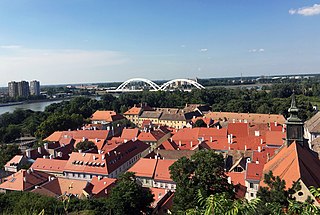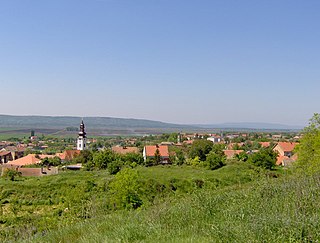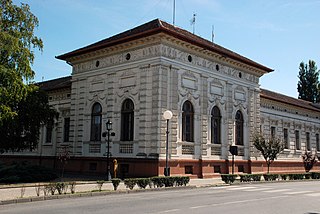
Austria-Hungary, often referred to as the Austro-Hungarian Empire or the Dual Monarchy, was a multi-national constitutional monarchy in Central Europe between 1867 and 1918. Austria-Hungary was a military and diplomatic alliance of two sovereign states with a single monarch who was titled both emperor of Austria and King of Hungary. Austria-Hungary constituted the last phase in the constitutional evolution of the Habsburg monarchy: it was formed with the Austro-Hungarian Compromise of 1867 in the aftermath of the Austro-Prussian War and was dissolved shortly after Hungary terminated the union with Austria on 31 October 1918.

Petrovaradin is a historic town in the Serbian province of Vojvodina, now a part of the city of Novi Sad. As of 2011, the urban area has 14,810 inhabitants. Lying on the right bank of the Danube, across the main part of Novi Sad, it is built around the Petrovaradin Fortress, the historical anchor of the modern city.

The Treaty of Karlowitz, concluding the Great Turkish War of 1683–1697, in which the Ottoman Empire was defeated by the Holy League at the Battle of Zenta, was signed in Karlowitz, in the Military Frontier of the Archduchy of Austria, on 26 January 1699. Also known as "The Austrian treaty that saved Europe", it marks the end of Ottoman control in much of Central Europe, with their first major territorial losses in Europe, beginning the reversal of four centuries of expansion (1299–1683). The treaty established the Habsburg monarchy as the dominant power of the region.

The Military Frontier was a borderland of the Habsburg monarchy and later the Austrian and Austro-Hungarian Empire. It acted as the cordon sanitaire against incursions from the Ottoman Empire.

Bačka or Bácska is a geographical and historical area within the Pannonian Plain bordered by the river Danube to the west and south, and by the river Tisza to the east. It is divided between Serbia and Hungary. Most of the area is located within the Vojvodina region in Serbia and Novi Sad, the capital of Vojvodina, lies on the border between Bačka and Syrmia. The smaller northern part of the geographical area is located within Bács-Kiskun County in Hungary.

The Croatian Military Frontier was a district of the Military Frontier, a territory in the Habsburg monarchy, first during the period of the Austrian Empire and then during Austria-Hungary.

The Habsburg monarchy, also known as Habsburg Empire, was the collection of empires, kingdoms, duchies, counties and other polities that were ruled by the House of Habsburg. From the 18th century it is also referred to as the Danubian monarchy or the Austrian monarchy.

Cetingrad is a municipality in Karlovac County, Croatia near Croatia's border with Bosnia. The population of the village itself is 319, while the total municipality population is 2,027 (2011). The municipality is part of Kordun. Cetingrad is underdeveloped municipality which is statistically classified as the First Category Area of Special State Concern by the Government of Croatia.

Titel is a town and municipality located in the South Bačka District of the province of Vojvodina, Serbia. The town of Titel has a population of 5,247, while the population of the municipality of Titel is 15,738. It is located in southeastern part of the geographical region of Bačka, known as Šajkaška.

Srbobran is a town and municipality located in the South Bačka District of the autonomous province of Vojvodina, Serbia. The town is located on the north bank of the Danube-Tisa-Danube canal. The town has a population of 12,009, and the municipality of 16,317.

The Kingdom of Dalmatia was a crown land of the Austrian Empire (1815–1867) and the Cisleithanian half of Austria-Hungary (1867–1918). It encompassed the entirety of the region of Dalmatia, with its capital at Zadar.

Opovo is a town and municipality located in the South Banat District of the autonomous province of Vojvodina, Serbia. The town has a population of 4,546, while Opovo municipality has 10,475 inhabitants.

The Slavonian Military Frontier was a district of the Military Frontier, a territory in the Habsburg monarchy, first during the period of the Austrian Empire and then during the Austro-Hungarian Monarchy. It was formed out of territories the Habsburgs conquered from the Ottoman Empire and included southern parts of Slavonia and Syrmia; today the area it covered is mostly in eastern Croatia, with its easternmost parts in northern Serbia

Pećinci is a village and municipality located in the Srem District of the autonomous province of Vojvodina, Serbia. The village has a population of 2,581 (2011), while Pećinci municipality has 19,720 inhabitants.

Kovin is a town and municipality located in the South Banat District of the autonomous province of Vojvodina, Serbia. The town has a population of 13,515, while the municipality has 33,722 inhabitants.

The fortress of Cetin is situated 5 kilometres (3 mi) south of Cetingrad above the village of Podcetin, in Croatia. The castle and its immediate surrounding represent a monument of great value for Croatian national history because on this place in 1527 Croatian nobility elected Ferdinand I Habsburg a king of Croatia. From that moment on, Croatia remained a part of Habsburg Monarchy until the end of World War I.

The Magnate conspiracy was a plot among Croatian and Hungarian nobles to oust the Habsburg Monarchy from Croatia and Hungary, in response to the Treaty of Vasvár in 1664. This treaty - which ended the Fourth Austro-Turkish War - was highly unpopular in the Military Frontier, and those who were involved in the conspiracy intended to reopen hostilities with the Ottoman Empire after they broke away from Habsburg rule.

Hrtkovci is a village located in the municipality of Ruma, Serbia. As of 2011 census, it has a population of 3,036 inhabitants.

The Kingdom of Croatia was part of the Lands of the Hungarian Crown, but was subject to direct Imperial Austrian rule for significant periods of time, including its final years. Its capital was Zagreb. It was also a part of the lands of the Habsburg monarchy from 1527, following the Election in Cetin, and the Austrian Empire from 1804 to 1867.

The liberation of Cetingrad was a military conflict between the Croatian Corps of the Habsburg monarchy's army, led by Feldzeugmeister Joseph Nikolaus Baron de Vins, and the Ottoman army, led by Dizdar-Agha Ali-Bey Beširević, dealing with possession of Cetin Castle and its surrounding area, in central Croatia. The conflict was part of a military campaign within the Austro-Turkish War (1788–1791). Habsburg forces besieged the castle between 22 June and 20 July 1790, and, after almost a month, the operation ended victoriously for the Habsburg troops. Cetingrad, an important stronghold in the Croatian Military Frontier that had fallen into the hands of the Ottoman conquerors in the 16th century again became part of the Kingdom of Croatia.





















